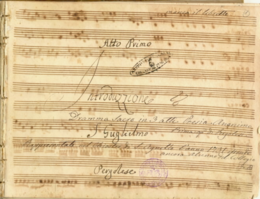La conversione e morte di San Guglielmo
| La conversione e morte di San Guglielmo | |
|---|---|
| Dramma sacro by G. B. Pergolesi | |

First page of the complete manuscript score kept at the Conservatorio San Pietro a Majella
|
|
| Translation | The Conversion and Death of Saint William |
| Librettist | Ignazio Mancini |
| Language | Italian |
| Based on | life of William X, Duke of Aquitaine |
| Premiere | 1731 Sant'Agnello Maggiore, Naples |
La conversione e morte di San Guglielmo (The Conversion and Death of Saint William) is a sacred musical drama (dramma sacro) in three parts by the Italian composer Giovanni Battista Pergolesi. The libretto, by Ignazio Mancini, is based on the life of Saint William of Aquitaine as recounted by Laurentius Surius. It was Pergolesi's first operatic work, possibly written as a study exercise for his conservatory. The work was premiered at the Monastery of Sant'Agnello Maggiore, Naples in the summer of 1731.
In 1731 Pergolesi's long years of study at the Conservatorio dei Poveri di Gesù Cristo in Naples were drawing to a close. He had already begun to make a name for himself and was able to pay off his expenses by working as a performer in religious institutions and noble salons, first as a singer then as a violinist. In 1729-1730 he had been "capoparanza" (first violin) in a group of instrumentalists and, according to a later witness, it was the Oratorian Fathers who made most regular use of his artistic services as well as those of other "mastricelli" ("little maestros") from the Conservatorio. The first important commission Pergolesi received on leaving the school was linked to this religious order and on 19 March 1731 his oratorio La fenice sul rogo, o vero La morte di San Giuseppe ("The Phoenix on the Pyre, or The Death of Saint Joseph") was performed in the atrium of their church, today known as the Chiesa dei Girolamini, the home of the Congregazione di San Giuseppe. "The following summer Pergolesi was asked to set to music, as the final exercise of his studies, a dramma sacro in three acts by Ignazio Mancini, Li prodigi della divina grazia nella conversione e morte di san Guglielmo duca d’Aquitania ["The Miracles of Divine Grace in the Conversion and Death of Saint William, Duke of Aquitaine"]. The performance took place in the cloisters of the monastery of Sant'Agnello Maggiore, the home of the Canons Regular of the Most Holy Saviour." The libretto was supplied by a lawyer, Ignazio Maria Mancini, "who indulged in poetical sins as a member of the Arcadian Academy under the name Echione Cinerario. [...] The audience was made up of habitués of the Congregation of the Oratorians, in other words 'the cream of Naples' ...and its success was such that the Prince Colonna di Stigliano, Scudiere of the Viceroy of Naples, and Duke Carafa di Maddaloni - both of them present - promised the 'little maestro' their protection and opened the doors of the Teatro San Bartolomeo to him, then one of the most popular and important theatres in Naples," where Pergolesi was soon commissioned to write his first opera seria, La Salustia.
...
Wikipedia
